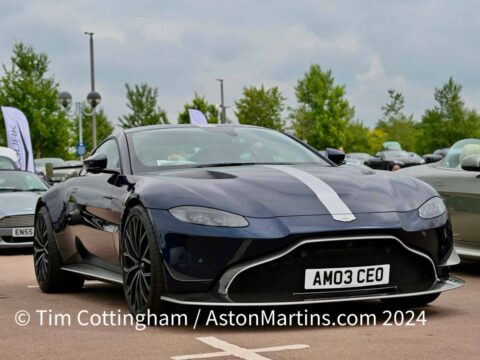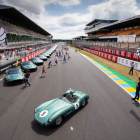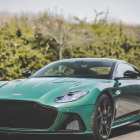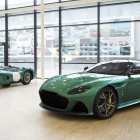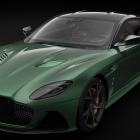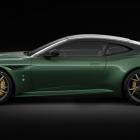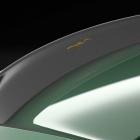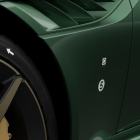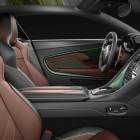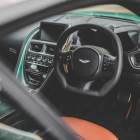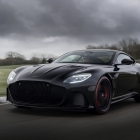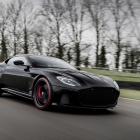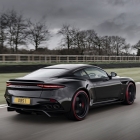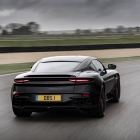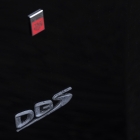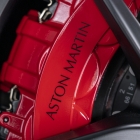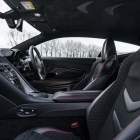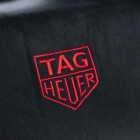Vantage AMR 59
- 10/09/2019The standard colour scheme for the ’59’ cars was as you might expect, signature AMR Stirling Green with front to back AML Lime Green stripe.
The specification of the Vantage AMR 59 Edition was as follows
Stirling Green Paint with Lime Halo Graphic + 59 Logo on Bonnet
2×2 Twill Gloss Carbon Fibre Exterior Body Pack including decklid insert, bonnet vents, louvered side gill, mirror caps and roof
Lime Rear Diffuser Insert and Blades
Exterior Black Collection including Matte Black Window Surround and Front Grille
Smoked Tail Lamps
20“ Textured Black AMR Wheel
AMR Lime Green Brake Calipers
Quad Matte Black Exhaust
Enamel wing badges
Silver underbonnet cross brace
Sport Plus Collection (Sports Plus Seat and Sports Steering Wheel)
Dark Knight Leather and Dark Knight Alcantara with Lime Stripe and Lime Stitch
Exclusive 59 Logo Embroidery in Silver
DBS Superleggera Coupe
- 11/05/2018Vantage AMR
- 10/09/2019DB9 Coupe (2011MY & 2012MY)
- 31/01/2013The very best way to identify this rare variant is the shape of the vents either side of the air dam turn downwards instead of upwards on the earlier models.
The Adaptive Damping System, as first used on the DBS became available as standard equipment and thus the Premium Sports Pack was no longer offered as an option.
By the time the 2012MY DB9 entered production (from mid 2011), manual transmission was no longer available of the car even as an cost option. Also, in line with the new Virage, the car adopted the Garmin sat-nav and ‘beam blade’ wiper design, incorporating Bosch Aerotwin wiper blades.
The 2011/2012 MY cars are considered and are the rarest of the DB9’s built in relatively small numbers. Buyers of the period bought either the new DBS, Rapide or the latest Virage models instead. Manual transmission 2011MY DB9’s are extremely scarce indeed.
DBS Superleggera 59 Special Edition
- 24/01/2019The car was announced in November 2018 with the intention that all cars would be completed and sold before the following June. The dramatic handover ceremony on the start line of the Le Mans circuit before the 2019 running of the classic endurance race was an outstanding success.
If I’ve done my maths right, there have been three previous Le Mans models from Aston Martin. The 1932 1.5 litre Le Mans, the 1999 V8 V8 Vantage Le Mans and the 2008 DB9 LM.
Vantage Coupe manual
- 29/05/2024DB9 SE ‘Sports’ (Carbon Black / Quantum Silver)
- 31/01/2013The specific features of the DB9 Sports are below
- Touchtronic 2 gearbox as standard, no manual option
- Sports exhaust with revised flap valve map
- 19 inch 10 spoke forged gloss black diamond turned wheels
- Black brake callipers
- Clear tail lamps
- Black mesh bonnet and side strake grilles, black lower front and rear grilles
- Graphitic tail pipes
- Semi-aniline black leather interior with course silver stitch and perforated seat inners (coupe)
- Obsidian Black leather interior with course silver stitch and perforated seat inners (Volante)
- Full width Piano Black facia, door handles and door cappings
- Black semi-aniline leather headlining with silver stitch (coupe)
- Black hood with Tailors Grey headlining (Volante)
- DBS Instrument surround and graphics
- DBS Leather steering wheel with black airbag ring, green wings badge with silver stitch
- Black tread plates with ‘Carbon Black’ or ‘Quantum Silver’ model name inserts
It would appear that a majority of the Special Edition Sports models were sold in the UK.
DBS Superleggera TAG Heuer Edition
- 24/01/2019The Aston Martin DBS Superleggera TAG Heuer Edition has coachwork in Monaco Black paint with a satin black tinted carbon fibre roof, mirrors, vents, louvres, splitter and spoiler. The bespoke specification includes satin black 21” twin spoke wheels fitted with Pirelli P Zero Colour Edition tyres with a red accent to complement the red brake calipers. If the unique livery with red highlighting doesn’t give away the model type, the wing badge with TAG Heuer logo will do so.
Inside, the DBS boasts pure black leather and alcantra seats with red stitching and bespoke TAG Heuer quilting, each displaying the TAG Heuer logo, and carbon fibre and dark chrome has been used throughout to accentuate the clean lines of the cockpit.
Each of the 50 cars was inspected personally by Aston Martin Lagonda President and Group CEO, Andy Palmer, before leaving the factory.
DB9 Coupe ‘Sport Edition’
- 11/08/2013Specification of the DB9 Sport edition is as follows:
- Available with both coupe or Volante coachwork
- Touchtronic 2 automatic transmission only
- Choice of exterior colours from the ‘Fast Track’, ‘Contemporary’ and ‘DBS Special’ ranges
- 10-spoke forged wheel with a gloss black and diamond turned finish. This is then individually machined on a 5-axis milling machine to produce a ‘pin-stripe’ along each spoke which is then painted gloss black
- Black brake calipers with other colours available as an option
- Black finish on the bonnet, side strakes, lower front and rear mesh grilles (optional magnum silver)
- Graphitic tailpipe finish and sports exhaust
- Interior available with all colours from the Fast Track and Contemporary range
- Seat centres, door inserts and instrument binnacle in perforated leather with a contrast stitch
- Quilted leather headlining and co-ordination Alcantara cant rails on the coupe
- Black hood on the Volante with Black, Tailors Grey or Ivory headlining
- ‘DB9’ headrest embroidery
- Piano Black facia
- Glass switches
- Unique sill plaques, numbered 1 to 60
The DB9 Sport Edition was never publicly marketed, only directly and personally to existing customers of North American, Australian and New Zealand dealerships.

